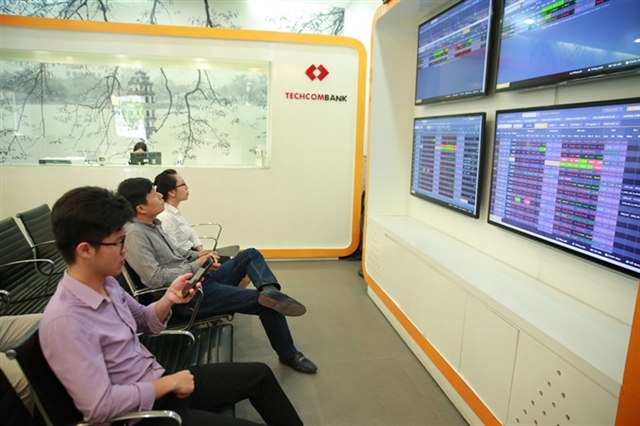 Economy
Economy


|
| Investors at a VNDirect Securities Company trading floor. — VNS Photo Trương Vị |
HÀ NỘI — The market is forecast to move sideways with alternative ups and downs in a narrow range next week, analysts have predicted.
The benchmark VN-Index on the Hồ Chí Minh Stock Exchange slid 0.06 per cent to close at 989.20 points, totalling a weekly loss of 0.27 per cent.
On the Hà Nội Stock Exchange, the HNX-Index edged down 0.55 per cent to end Friday at 105.48 points. The index had risen 0.21 per cent on a weekly basis.
An average of 213.9 million shares was traded on the two exchanges last week, worth VNĐ4.3 trillion (US$183 million).
According to Ngô Quốc Hưng, senior analyst at MB Securities Co's market strategy department, thinking positively, the Vietnamese market will keep its upward trend with slight fluctuations.
“Liquidity may remain below VNĐ3 trillion on the HOSE,” Hưng told news site tinnhanhchungkhoan.vn.
Listed companies were publishing their third quarter earnings reports, which could lead to a divergence among stock. Foreign investors had reduced their net selling and switched to net buying in the past week, Hưng said.
He said: “Technically, the VN-Index is in the accumulation stage so the index may fluctuate in a narrow range before a clearer trend appears.”
Global economic growth was slackened due to trade conflicts, instability around the Brexit agreement and uncertainties of trade policies, Hưng said.
Last week, the International Monetary Fund (IMF) lowered its forecast for world economic growth in 2019 to 3 per cent. Therefore, central banks around the world continue to lower interest rates, he said.
On the stock market, whenever economic data deteriorated, investors tend to expect central banks to cut interest rates further to prevent worse economic downturn. Therefore, whenever interest rates are cut, the stock markets go up, Hưng said.
“In general, the main trend of the market in October is fluctuating in a narrow range. VN-Index is in the "sideway" phase, which is usually the most time consuming period in the financial market,” said Nguyễn Anh Khoa, head of Market Analysis and Investment Advisory at Agribank Securities Co (Agriseco).
The market might still keep following this path for a while and wait for a change that could draw a new trend for stocks.
“In recent months, the Vietnamese stock market had not been affected much by the developments of international fluctuations,” Khoa said.
According to Phan Dũng Khánh, director of investment consultancy at Maybank Kim Eng Securities, the market remained short on cash flow. Foreign investors kept net selling, so large-cap stocks and major sectors were not supported and could not maintain the upward momentum.
“Therefore, it is difficult to have a positive upward trend in the near future,” Khánh said.
“However, the VN-Index still has the ability to conquer the 1,000-point landmark but the index may find it difficult to maintain this level,” Khánh said.
The National Bureau of Statistics of China (NBS) on October 18 said in the third quarter of 2019, the country's economy grew by 6 per cent, the lowest level since March 1992. The Chinese economy continues to decelerate sharply under the pressure of the trade war with the US.
According to Bảo Việt Secuties Company (BVSC), the record low growth rate shows the prolonged recession and the US-China trade war have seriously affected the production and exports of the world's second largest economy.
Beijing has set a target of 6-6.5 per cent for 2019 economic growth. With the slowdown, the Chinese economy is likely to reach the lower end of the target range. Beijing has boosted its support for the economy with tax cut, interest rates reduction and foreign investment restrictions on the stock market.
In the latest measure to support growth, the People's Bank of China (PBOC) on October 16 said it injected 200 billion yuan (US$28 billion) into the financial system through a medium-term lending mechanism for banks, in order to maintain liquidity in the market.
However, experts believe these efforts were not enough to compensate for the decline in domestic demand, BVSC said. — VNS









